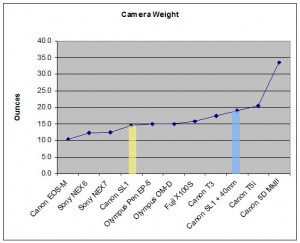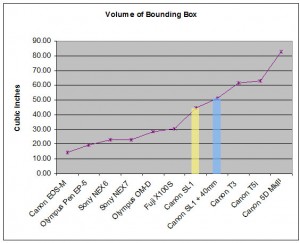I wrote about my impressions of the Canon SL1 in my last post about our trip to New Orleans. I decided to follow that up with some actual data regarding the size of the camera and how it compares to other choices I had considered. Warning – my inner geek is on display here!
First, let’s set the stage regarding my size considerations. To me, there’s a size and weight threshold – can I put it into a pocket? If I’m wearing a jacket or coat, then that threshold is a bit larger since I have bigger pockets. Some things I’ll put into a pocket that just fit but are really too heavy. I’ll do it, but it’s not comfortable, and I won’t like it. If I’m in my shirt sleeves, then it has to fit into a pants pocket. My iPhone does this, and it’s okay. And, indeed, it does have a usable camera.
A few years ago, I bought a Canon S90 point and shoot. It has some nice advanced features, and it does indeed fit well enough in a pocket. At the time, I considered the G10 which has much the same guts as well as a hot shoe and some other improvements. But, when looking it over, it was clear to me the G10 would not easily fit into a pocket – especially a pants pocket. I decided why should I buy a point and shoot camera that won’t fit into a pocket when I could just buy a smaller DSLR? So I went for the S90. It’s a reasonable camera, I’ve written about it here, but for my first trip to New Orleans, I wanted something with more capabilities.
So, are any of the mirrorless cameras pocketable? For me, I don’t think so. Perhaps I need to just use one for a while and really see, but at a glance, my conclusion was no. Okay, that puts all the cameras I’m looking at into the bigger-than-my-pocket class. I then thought about the weight. Would I be able to carry the camera all day without a second thought or a sore shoulder? Let’s look at some data.
These are the cameras I was looking at renting. I added my 5DMkIII for perspective! I also wasn’t really thinking about the EOS-M. It’s not been well received and has only the LCD display. I also wasn’t looking so much at the Pen. Had I rented Olympus, it would have been the OM-D, but I thought it was a good data point to add. I also added the T3 which is Canon’s low-end of their DSLR line. It’s a small and light camera, but the SL1 + 40mm lens is only a bit heavier than the T3 body alone. The SL1 has better specs as well – and it’s a lot more expensive.Also, notice I show the SL1 with and without the 40mm pancake lens. This makes it a more fair comparison to the Fuji which has a built in, noninterchangeable lens. It’s interesting how these cameras huddle around the one pound mark. The EOS-M is truly the lightweight here, and the Sony’s are amazingly light. I think it’s pretty incredible, though, that Canon put the SL1 into this league even though it has a pentaprism, mirror, and the various moving pieces needed to flop the mirror up and down. We have to admit, too, that Fuji did some great work in providing a camera + lens that is close to these other cameras. (Of course, without an interchangeable lens system, they can save weight otherwise needed in the mount.)
I added the T5i, the SL1’s big brother announced the same day for comparison. But look at the 5DMkIII compared to all the others. This is why it is an effort to carry all day. And, yes, for most of my shooting, I will happily carry that load! It’s a tremendous instrument.
This next chart is a little more geeky, and it needs some explanation. All these cameras are shaped differently. Some have very rounded corners, others are squared off. Some have lenses, some don’t. So how do we compare the sizes? Probably the pocket test would be good, but I don’t have all the cameras at my disposal. What I do have is the width/height/depth measurements.Thus, this chart shows the volume of the smallest regular rectangular box that could hold each camera. It’s basically width x height x depth. It’s not an ideal measurement, but it does give you some flavor of the overall size. We see that once again, Fuji has packed a lot into a small package. The 40mm pancake lens is interesting in that it’s so small, it doesn’t protrude much past the top of the SL1. I had to estimate this based on some images and some of my own measurements, but I think I’m pretty close.
I do wonder if the EOS-M might very well fit into a pocket. It’s light and small. We’ll have to see where Canon takes that line of cameras. The 5DMkIII again is vastly larger than the others making an interesting point on the chart.
Perhaps someone reading this post will find the data useful. Or, like me, maybe you just enjoy looking over this sort of data. There are obviously other cameras besides these that fall into this small and lightweight but very functional category. I didn’t include them because I wasn’t considering them myself. It’s also worth noting I used data from the manufacturers’ web sites. I believe I copied every number correctly. There was at least one mistake on a web page – Sony’s – and there could be others. I know Sony had the wrong data because the inches didn’t match the millimeters for one dimension on one camera. I converted the millimeters and used that.
For what it’s worth!



